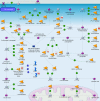Investigation of tumor hypoxia using a two-enzyme system for in vitro generation of oxygen deficiency
- PMID: 21477371
- PMCID: PMC3080288
- DOI: 10.1186/1748-717X-6-35
Investigation of tumor hypoxia using a two-enzyme system for in vitro generation of oxygen deficiency
Abstract
Background: Oxygen deficiency in tumor tissue is associated with a malign phenotype, characterized by high invasiveness, increased metastatic potential and poor prognosis. Hypoxia chambers are the established standard model for in vitro studies on tumor hypoxia. An enzymatic hypoxia system (GOX/CAT) based on the use of glucose oxidase (GOX) and catalase (CAT) that allows induction of stable hypoxia for in vitro approaches more rapidly and with less operating expense has been introduced recently. Aim of this work is to compare the enzymatic system with the established technique of hypoxia chamber in respect of gene expression, glucose metabolism and radioresistance, prior to its application for in vitro investigation of oxygen deficiency.
Methods: Human head and neck squamous cell carcinoma HNO97 cells were incubated under normoxic and hypoxic conditions using both hypoxia chamber and the enzymatic model. Gene expression was investigated using Agilent microarray chips and real time PCR analysis. 14C-fluoro-deoxy-glucose uptake experiments were performed in order to evaluate cellular metabolism. Cell proliferation after photon irradiation was investigated for evaluation of radioresistance under normoxia and hypoxia using both a hypoxia chamber and the enzymatic system.
Results: The microarray analysis revealed a similar trend in the expression of known HIF-1 target genes between the two hypoxia systems for HNO97 cells. Quantitative RT-PCR demonstrated different kinetic patterns in the expression of carbonic anhydrase IX and lysyl oxidase, which might be due to the faster induction of hypoxia by the enzymatic system. 14C-fluoro-deoxy-glucose uptake assays showed a higher glucose metabolism under hypoxic conditions, especially for the enzymatic system. Proliferation experiments after photon irradiation revealed increased survival rates for the enzymatic model compared to hypoxia chamber and normoxia, indicating enhanced resistance to irradiation. While the GOX/CAT system allows independent investigation of hypoxia and oxidative stress, care must be taken to prevent acidification during longer incubation.
Conclusion: The results of our study indicate that the enzymatic model can find application for in vitro investigation of tumor hypoxia, despite limitations that need to be considered in the experimental design.
Figures






References
-
- Comerford KM, Wallace TJ, Karhausen J, Louis NA, Montalto MC, Colgan SP. Hypoxia-inducible factor-1-dependent regulation of the multidrug resistance (MDR1) gene. Cancer Res. 2002;62:3387–3394. - PubMed
Publication types
MeSH terms
Substances
LinkOut - more resources
Full Text Sources
Other Literature Sources
Medical
Miscellaneous

